What can I wash my acrylic bathtub with? All about fastidious acrylic

Today in the world of sanitary ware, products made of acrylic have become very popular. Thus, cast iron and steel bathtubs have been replaced by lighter and more elegant acrylic bathtubs. In order for it to last as long as possible, you need to figure out some of the subtleties and nuances about caring for it. The material from which such products are made, has a number of features that form a number of advantages and disadvantages of acrylic baths. One of the disadvantages is that you can clean it only with special agents. What can I wash an acrylic bathtub with?
Types of acrylic baths
Depending on the method of manufacture, acrylic bathtubs can be of two types:
- Extruded - made by heating a sheet of polymer to a certain temperature and giving it the necessary shape with the help of the press. Such baths are somewhat less resistant to shape and require additional treatment with epoxy resin or fiberglass. They are installed on a metal frame;
- Cast - a special form is filled with molten acrylic. The properties of such a bath are somewhat better than the previous one, but the price, of course, is higher. It is also treated with epoxy for better preservation. And you can install it directly on the legs, without using a frame, but for this you need to be sure that the product is of high quality.
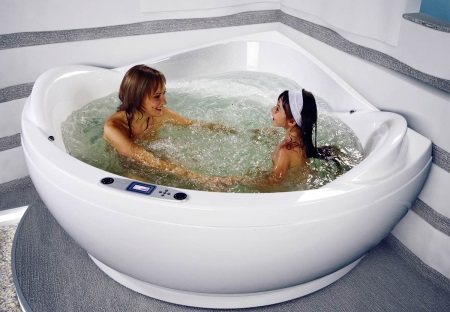
What is the reason for such popularity of acrylic baths and how do they differ from cast iron baths?
Advantages
- low weight of the product - the average weight of an acrylic bath - 20-25 kg. In this regard, it is easier to solve the problems of transportation and installation;
- a variety of forms and design solutions - acrylic allows you to create a variety of baths, even very unusual forms;
- high thermal insulation properties - water temperature decreases much more slowly - only 1 degree per half an hour;
- hygienic - not affected by fungus and mold;
- easy care - easy to clean even with the use of simple improvised means;
- no corrosion - this is due to the fact that acrylic is a chemically inert material, and therefore the emergence of rust is excluded, the enamel is not damaged;
- easy elimination of minor defects - small scratches can be removed with felt.
Thus, unlike cast iron baths, acrylic baths retain heat much longer. Another important difference is the ease of care and the elimination of certain types of dirt.
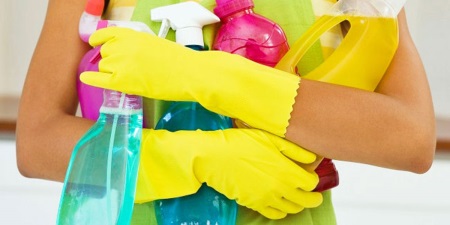
Disadvantages
In terms of the use of cleaning agents, there are many questions. So, the disadvantages of acrylic bathtubs:
- low level of durability - any fallen object in the tub can damage it, up to the formation of cracks and holes;
- Fear of high temperatures - high temperature is considered to be more than 150оbut if the acrylic is of low quality, it can deform and hot tap water;
- intolerance of some cleaning agents - requires special chemicals, cleaning powders are not allowed, because. they leave behind scratch marks;
- short service life - on average, polymer baths last no more than 10-15 years. Usually during this time the idea of a new repair will come up, so you don't have to worry about it.
And in order not to spoil the acrylic bathtub with cleaning agents, you need to know the peculiarities of care for it.
Rules and tips for cleaning
In order to ensure that the bathtub had an attractive appearance for longer, it is important to follow a few rules:
It is not recommended to put heavy objects in the acrylic bathtub, especially metal - they can leave marks and scratches;
- After each use, wash it with warm water and a soft sponge.
- After each cleaning, you should wipe the tub dry.
- Avoid contact of acrylic with acetone, chlorine, ammonia.
- Do not soak clothes in the tub.
- If you need to bathe your pet, use a mat to protect the surface from your pet's sharp claws.
- Acrylic bathtubs may be cleaned with chemicals once every ten days at the most, and aggressive detergents should be avoided altogether.
Use gentle detergents, so you will prolong the life of the polymer.
With regular care there will be no problem with removal of dirt, because acrylic has excellent dirt-repellent properties. And to make the bath shine after cleaning, you need to wipe it with a piece of soft cloth.
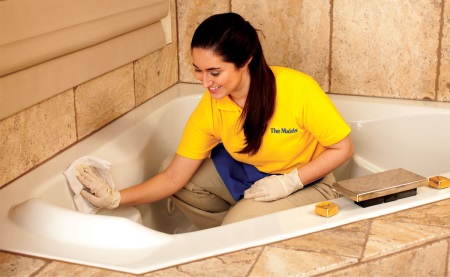
Among the best products designed to clean polymers are: Acryl Star, Bass, Cif, Mellerud, Triton, Ravak, Acrylan, Acryl Polish, Mr. Cleaner, Pani Bath, Sun Cline, Tim Pro.
Cleaning methods and procedure
An important point when cleaning an acrylic bathtub: do not work on a dry surface, it is fraught with damage to the polymer. It is necessary to use warm water and mild detergents. Liquid soap, dishwashing gel and shower gel are excellent. Rubbing with a hard sponge or, God forbid, a metal brush is strictly forbidden.
What is the procedure for cleaning an acrylic bathtub?
- On the walls of the bath and the area of visible contamination should be applied a cleaner.
- Leave it to "soak" for five minutes.
- Rinse with warm water with a soft sponge or tissue.
- If the dirt remains - repeat the procedure.
- Wipe dry.
There is nothing difficult to clean the acrylic bath, the main thing is to use the right detergents.
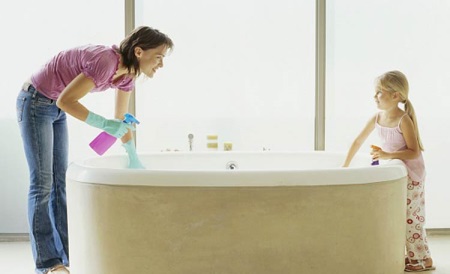
Cleaning with improvised means
When at home there is no suitable chemicals for the bath, you can use improvised means. One of these is wine vinegar. It copes well with stains and rust. To clean an acrylic bathtub, you need to moisten a rag in vinegar and apply it to the place of contamination, after a few minutes you can rinse. Similar in action is lemon juice or diluted citric acid.
You can also use ordinary soap or shower gel. For greater effect, you can fill the bathtub with warm water, dilute the soap or gel in it and let it stand for a while. After draining the water and rinsing the tub, and then wipe with a dry cloth.
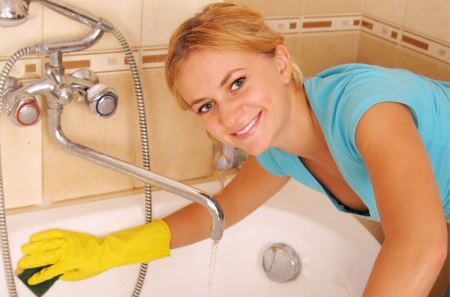
Removal of lime scale from water (water stone)
It is not as easy to cope with this type of contamination as with others. To effectively get rid of waterstone without damaging the coating of the bathtub, you must resort to one simple but very effective method. This method is really very good, but you should not use it more than once a year.
- Pour warm water into the tub.
- We pour in a bottle of vinegar and stir it.
- After 10-12 hours, drain the water and wipe the tub with a sponge.
- Rinse and wipe.
You can add baking soda to the vinegar.
If you can not wait that long, you can use special cleaners or dilute in a glass of citric acid 1:2. Then the solution is applied with a sponge to the lime scale, wait about 10 minutes, then repeat the procedure and gently start wiping the lubricated area. After rinsing with water. However, it is unlikely that this method will help if the layer of stone is quite large.
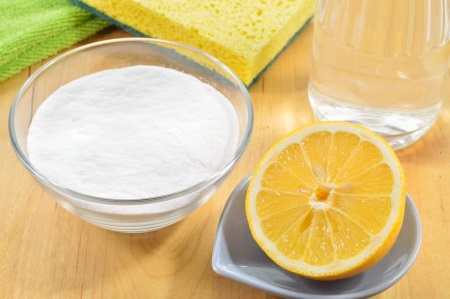
Rust
Acrylic is not susceptible to corrosion, but stains from rust flowing from under the faucet are a serious threat to the bathtub. To avoid such a problem, you can use the same citric acid. The surface of the bathtub treated in this way will remain white for a week. As a preventive measure, clean with citric acid once a month.
If the yellowing does not disappear, then you will have to use special cleaners.
Disinfection
With acrylic bathtubs in this regard there are no difficulties, because the polymer is not exposed to fungal lesions and mold. But you still need to disinfect from time to time to protect yourself and your loved ones from dangerous bacteria. To do this, dilute a disinfectant compatible with acrylic in a full bathtub and leave it for 10 minutes, that's enough time. After that, rinse the surface thoroughly with water. Now germs do not threaten your health.
How to remove scratches
A great advantage of cast acrylic bathtubs is the possibility of their restoration. If there is a scratch on the surface, it can be removed with tiny sandpaper. And to restore the former shine, rub it with polishing paste.
If you have a lot of small scratches, you can use felt. It is enough to rub the damaged place with this material, and the bathtub will look like new again.
If you follow the elementary rules of care for acrylic bathtubs, you can extend their life for years. The main thing - remember what you can wash acrylic baths, as well as regular cleaning, and then your bath will keep its shine and whiteness, and water procedures in it will take only pleasure!
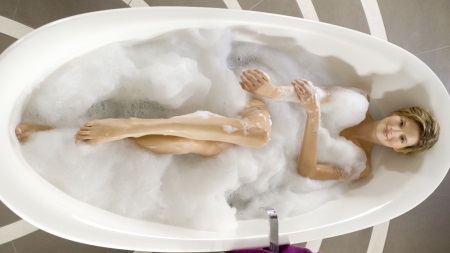





In general, I do not see any problems with the acrylic bathtub. Yes, you can't use abrasives, but if you clean it at least once a week, you won't have any problems. I wash my tub with a sponge and regular antiseptic liquid soap. Very happy with it.